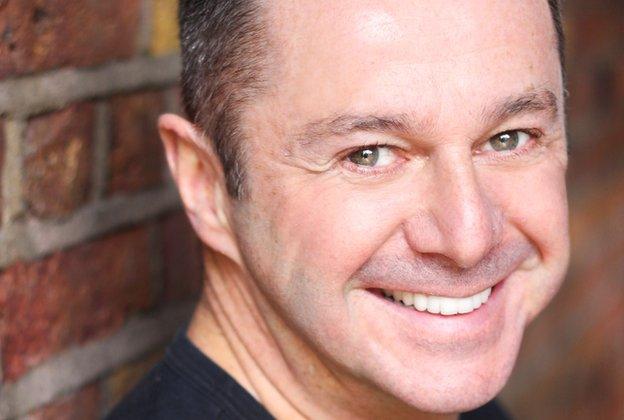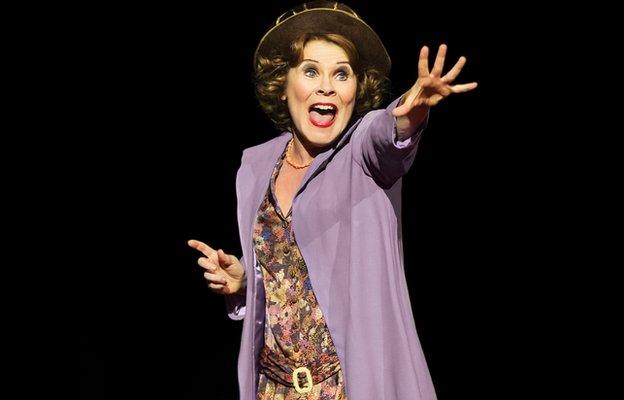Gypsy musical's dance man moves with the times
- Published

Imelda Staunton plays the driven mother of the fledging stripper Louise
Since it opened on Broadway in 1959 the reputation of Gypsy has grown: today it's widely regarded as a classic stage musical. The show evokes the seedier end of American theatrical life in the 1920s and 30s, as shy young Louise Hovick grows up to become renowned stripper Gypsy Rose Lee.
Choreographer Stephen Mear has to make the dance numbers work for a new West End production at the Savoy Theatre - so has he dared tamper with an established formula?
The Savoy Theatre boasts one of London's most glittering and glamorous auditoriums - almost too much so for a show which delves deep into the grubbier side of American vaudeville and burlesque before World War Two.
But, after launching the show last autumn in Chichester, Mear has relished restaging it for a traditional proscenium arch theatre, he says.
"The strange thing is that, though audiences enjoy the dance elements in Gypsy, it's not a big dance show in the way that West Side Story is," adds the choreographer.
Gypsy's original choreographer and overall director was Jerome Robbins. "That meant the dancing was always seamlessly incorporated into the show and of course we want to do the same thing."

Stephen Mear faced a big challenge in taking the classic choreography and adapting it for a modern audience and interpretation
For decades it was common for special coaches, known as repetiteurs, to be employed on revivals of classic Broadway musicals to reproduce something like the original choreography. This revival of Gypsy is under no such obligation.
"But I happily tip my hat to what came before. Jerry Robbins had a superb gift.
"There's a fantastic and wonderfully vulgar number in the second act called You Gotta Get a Gimmick in which three strippers explain how to make it.
"The song has some of Stephen Sondheim's wittiest lyrics and the original choreography set them perfectly. So that's an instance where we're doing basically what they did 56 years ago."
Roughly half of Jule Styne's vibrant score consists of numbers performed in the story by Louise and her sister Baby June, under the forceful guidance of their mother Rose, played by Imelda Staunton.
We see the act first in down-at-heel vaudeville theatres - the equivalent of British music hall - but Louise progresses to burlesque, where gags are cruder and the girls less clothed.
Mear found the trick with those numbers was not to make the dancing too accomplished. "Initially Momma Rose has to come over as a woman of great drive but limited talent.
"I had to remind myself to choreograph through her eyes. She's not a great teacher and even as a teenager Louise is left doing a cute kiddy act.

Momma Rose harbours resentment over her daughter's success, thinking she could have done the same or better
"There needs to be something tacky and clunky about the way they dance but audiences still have to enjoy those numbers. Fortunately alongside the darker moments there's a lot of humour in how Arthur Laurents crafted the script."
Former Dr Who star Peter Davison is joining the cast to play Herbie, the man Momma Rose comes close to marrying. "Peter's role doesn't call for full-on dance skills but he is part of a lovely, tongue-in-cheek number called Together Wherever We Go. It's very vaudeville and it turns out to be one of the best things in the show. I'm proud of what we've done with it."
At the other end of the dance spectrum there's a long and sexy strip number for the older Louise, played by Lara Pulver. "There are certain things I include because in real life that's what Louise did in her act once she became Gypsy Rose Lee.
"There's playing with the long gloves, the way she uses the curtains, the bit where you think the dress will drop but it doesn't. In fact Gypsy Rose Lee never appeared naked - she just suggested it.
"It was a delight to have the percussionist working with us in rehearsal for the strip sequence. I would say: "Could we have a high-hat cymbal at that moment, a snare here, a rattle there?'
"And I love the big solo dance number when we see June bewitched by a handsome young dancer who shows off his act.
"For that you need what people call a triple threat - someone who can act, sing and is a fantastic dancer. The guy playing the role is Dan Burton who fortunately I've worked with before.

Peter Davison, who plays Momma Rose's love interest, is not called upon to do much dancing but he adds significantly to the humour in the show, says Stephen Mear
"So I know exactly what tricks Dan can pull on stage, which leg he turns on - all those specific details which mean I could build the dance to show off his talent and make the scene really exciting. Plus as a singer he has to hit a top G: that really sorted people out in the auditions."
Mear insists it's not a problem for him that the show has an overall director in Jonathan Kent. "With a gifted director like Jonathan you reach a shared view of what the dance needs to achieve. It's not a matter of suddenly going from his input to mine, like a light being switched on and off. Brilliant directors are always collaborative."
Gypsy contains humour and high spirits but its climactic scene, a solo for Rose, can be one of the most dramatic moments in modern American drama - musical or otherwise.
Staunton has to unleash all the resentment and frustration she's felt for years watching her daughter become a star and all the time thinking she might have done it as well or even better. As a study of failure and remorse it anticipates some of Sondheim's later work writing both words and music.
Mear says it was another moment where director and choreographer needed to collaborate intimately.
"I've seen productions of this show where at the end the actress playing Rose didn't - or maybe couldn't - let the audience see what an angry and ugly moment it is. Rose is asking if her life has been wasted - not exactly what you expect from a Broadway musical.
"Just the way Imelda moves about the stage shows us Rose suffering some sort of mental breakdown. The choreography contributes of course but at that moment Imelda Staunton is a volcano up there. It just builds and builds.
"My work as choreographer is part of the effect. But sometimes in theatre you just stand back and let a great performer perform."
Gypsy can be seen at London's Savoy Theatre until July.